Lori Robinson's Blog, page 6
October 28, 2019
10 Reasons Kenya offers an Amazing African Safari Experience
There are nine countries in Africa that offer an amazing African safari experience. All for different reasons.
I’ve been traveling all over Africa for 34 years, yet I continually choose Kenya (and Tanzania) for clients, especially if it’s their first safari.
Here’s why Kenya is my top choice for an Amazing African Safari Experience:
LARGE NUMBERS OF ANIMALS [To see what I am talking about check out the videos of my safari travels on FaceBook and Instagram ]
The Masai Mara in Kenya and the Serengeti in Tanzania form The Greater Serengeti Ecosystem. One of the largest protected ecosystems on Earth, its 40,000 square kilometers (25,000 square miles) is home to the big five (elephant, lion, leopard, buffalo, and rhino).
Every year a million wildebeest, half a million gazelle and 200,000 zebra follow the rains and fresh grass in a continual semi-predictable circle within these two areas. So if you time it right, and go to the right camps, you will witness the largest migration on earth.
Although the Mara is the most popular reserve in Kenya, there are other gems as well. Tsavo and Amboseli have huge numbers of elephants including the big tuskers. The Samburu region is home to endemic endangered animals such as grevy’s zebra, reticulated giraffe, and hirola.
PREDATORS
Where there is prey, there are predators. The Mara is the location for shows like the Big Cat Diaries. Discovery Channel and Animal Planet film many of their African wildlife segments here. Why? Because the Masai Mara offers quintessential Africa scenery and experiences. The wide-open plains make it easy to find lots of wildlife.
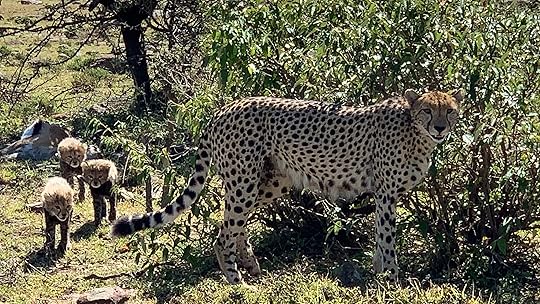 There are lots of African big cats in the Mara, like this cheetah mom.
There are lots of African big cats in the Mara, like this cheetah mom.
CULTURAL INTERACTIONS
The Maasai Mara is owned by the Maasai people and managed in partnership with the Kenyan Government and the lodge companies. The camps and lodges have lease agreements with the Maasai people so that everyone benefits. This is a model duplicated across Kenya. Your visit benefits the local people. Depending on where you are in Kenya, The Maasai and Samburu people work at the lodges, and your stay can include a visit to a traditional Maasai or Samburu village.
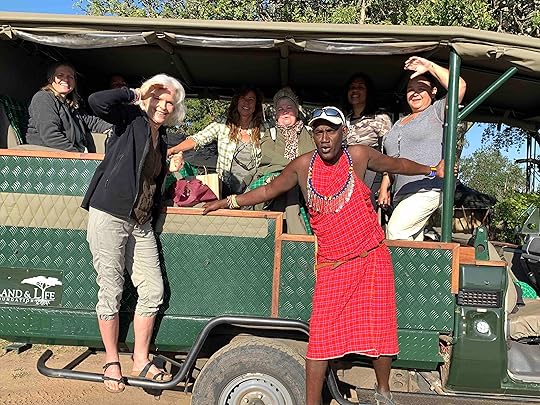 Our Masai guide, Daniel, and I fooling around with my group of women.
Our Masai guide, Daniel, and I fooling around with my group of women.
FRIENDLINESS
My safari clients consistently comment on how friendly the local people are. From the passport control, hotel staff, safari operators and people working at the camps where you stay, everyone is smiling and welcoming. One of my clients, comparing the friendliness here to the famous “aloha” attitude of the Hawaiian people, said Kenya wins.
“Kirubu” which means welcome in the local KiSwahili language, is one of the most commonly used words in Kenya. Not only are the people friendly but the country wants tourists and foreigners. They love us. “They help our economy,” is how my taxi driver describes it. And almost everyone speaks English.
LEADING EDGE CONSERVATION
Kenya is the only safari country that has had a consistent no-hunting policy (in place since 1977). A couple of years ago the government added a ‘shoot to kill policy’ to combat poaching.
Kenya is also home to some of the top conservation NGO’s in the world. Lewa Wildlife Conservancy helped build the first elephant corridor, an underground tunnel that allows elephants to cross under the busy Meru/ Nanyuki highway. Ol Pejeta Conservancy is a sanctuary for the last two Northern White Rhinos left in the world. And the gold standard for successfully raising orphaned baby elephants originated here in Kenya.
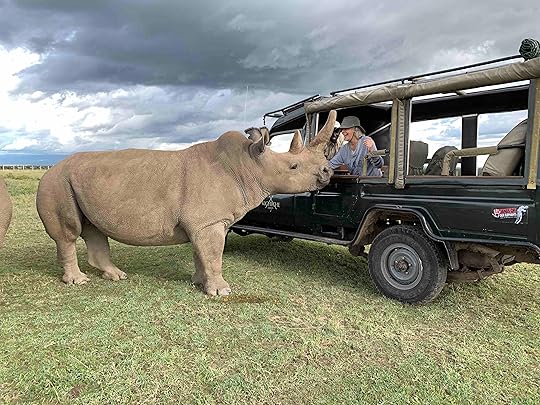 Ol Pejeta sanctuary has the last two Northern White rhino left in the world, a mother and daughter. The daughter and I share an emotional moment.
Ol Pejeta sanctuary has the last two Northern White rhino left in the world, a mother and daughter. The daughter and I share an emotional moment.
IDEAL WEATHER
British expats talk about the sunshine as one reason they love it here. But this is not the hot African sun of your imagination. Most of where you go on safari in Kenya is at an altitude of 3,000-5,000 feet. This keeps the temperatures cooler than many other places on the continent. The hottest months here are January and February, but most of the year expect temperate day time temperatures and cool nights.
EASE OF GETTING AROUND
Tourism is the number one contributor to the economy here. That means the country is very accommodating to its foreign visitors. Wilson is a small Nairobi airport dedicated to flying khaki-clad safari bound tourists. And there is a train that goes from Nairobi to the coast. English is spoken in the cities and at all the safari destinations.
WIDE VARIETY OF OPTIONS FOR AN AMAZING SAFARI EXPERIENCE
Safari packages range from rustic to luxurious. That means no matter what your budget you can experience at least a basic safari experience. Nairobi is the only city in the world that has a National Park (lions, giraffe, zebra … ) within its boundaries. So you don’t need to go far to see a few of the ‘big five’ animals.
NAIROBI’S WORLD FAMOUS ATTRACTIONS
Daphne Sheldrick Elephant Orphanage
Karen Blixen Museum
The Maasai Market and other craft stores
A KENYAN SAFARI NEVER DISAPPOINTS (but see my caveat below)
For all of the nine reasons mentioned above, Kenya gives safari travelers a life-changing journey full of wildlife encounters and cultural experiences in a friendly comfortable setting.
Caveat: Despite all of this, you still need to know when to travel to Kenya and where the best parks and camps are in order to get all that Kenya has to offer.
Contact me to get started on creating an amazing African safari experience.
The post 10 Reasons Kenya offers an Amazing African Safari Experience appeared first on .
April 16, 2019
Great African Safaris are Not Tours
It’s finally time to turn your dreams of going on an African safari into reality!
I’m leading three new great African safaris in 2020 to Botswana, Tanzania, and Kenya.
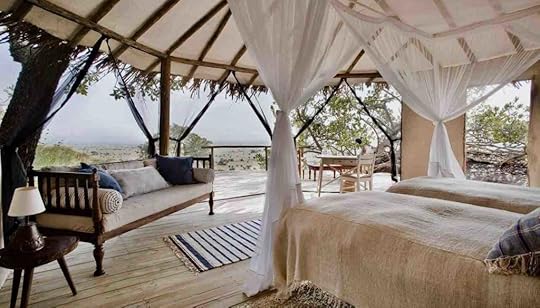 Typical style small tented camps in my itineraries.
Typical style small tented camps in my itineraries.Each itinerary includes the best spots in each country for maximum wildlife, and are all-inclusive from start to finish. The accommodations are small chic camps intimately connected to Nature. We listen to lions roaring and animals walking by our tents at night. The food is fresh, organic and wonderful, the driver/guides and services are top notch throughout. Each group is a maximum of six people with like-minded interests. All you need to do is relax, unwind, and enjoy while I take care of everything.
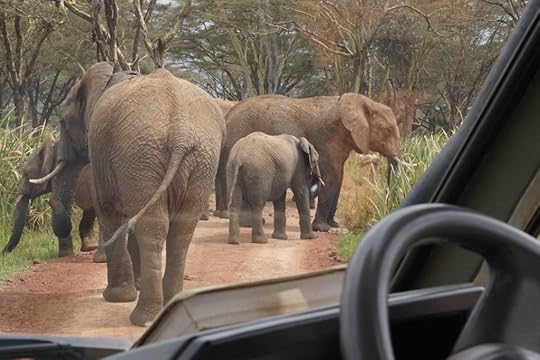
Great African safaris are not tours. They are experiences.
My safaris are known for having very close encounters with wildlife, and non-touristy activities available from my wide network in Africa.
There are many reasons why you shouldn’t wait to go on a safari. You can read about it HERE.
I’ve been leading Great African Safaris since 2004, am the author of two books on wildlife conservation, and worked for Jane Goodall for many years.
Read what Jane Goodall and others have to say about going on safari with me HERE.
Which of these Great African Safaris is perfect for you?
Botswana – January 20 – 28, 2020
January is Botswana’s green season. This special journey includes three uniquely different areas. We will travel from the Kalahari desert, where we meet the San Bushmen, our oldest living relatives, on to the Okavango Delta, where we traverse land and water, in jeeps and dug out canoes, among some of the widest varieties of wildlife in the world.
Email me to request a brochure with all the details.
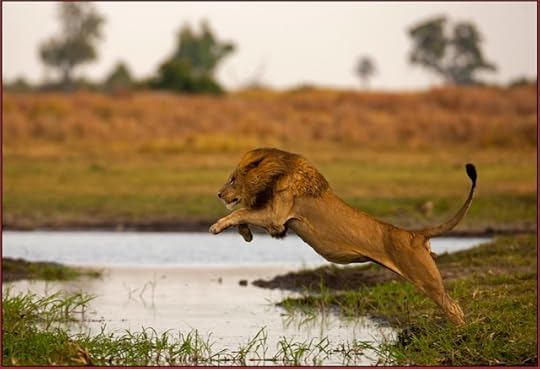
Tanzania – January 31- February 8, 2020
This journey includes the Ngorongoro Crater (one of the 7 Wonders of the World), the infamous Serengeti, and Olduvai Gorge (the Cradle of Mankind). We will visit a Maasai village, Manyara National Park, and the wonderful Gibbs Farm. This time of year we are also most likely to see the wildebeest migration. This is a perfect safari for first-time travelers to Africa.
Email me to request a brochure with all the details.
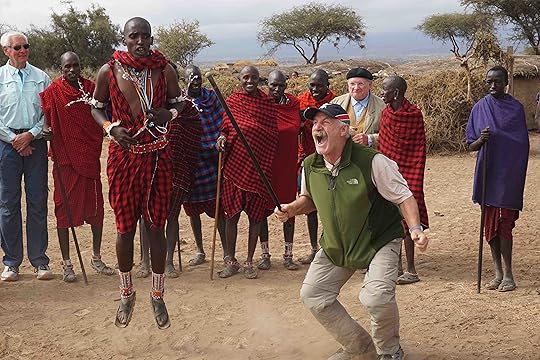
Kenya – September 24 – October 3, 2020
We will visit three completely different Parks – Lewa, the Masai Mara, and the Samburu area in Northern Kenya. Jam-packed with wildlife, this trip guarantees rhino sightings, and the wildebeest migration. We will also take a behind the scenes tour of a new elephant orphanage, visit the singing wells, and meet with anti-poaching rangers. This is a perfect choice for first-time safari travelers as well as people who would like a mix of wildlife and cultural experiences.
Email me to request a brochure with all the details.

Take the first step in making your dream a reality. Contact me to request a brochure or set up a time to talk. Don’t see what you are looking for. Let me help custom design your perfect safari.
Contact me now: LoriSavingWild@gmail.com
The post Great African Safaris are Not Tours appeared first on .
March 27, 2019
Lori Robinson’s Ultimate Guide to Planning an African Safari
If you’ve begun researching and planning an African Safari you know it’s a daunting task. The internet offers hundreds, if not thousands, of different answers for each of your safari queries.
But in the case of traveling to Africa, the best safari experiences absolutely do depend on when, where and how you go. Time your trip correctly, chose the top country, and the best parks and camps within that country, and use an operator who is well versed in Africa and you will have the trip of a lifetime.
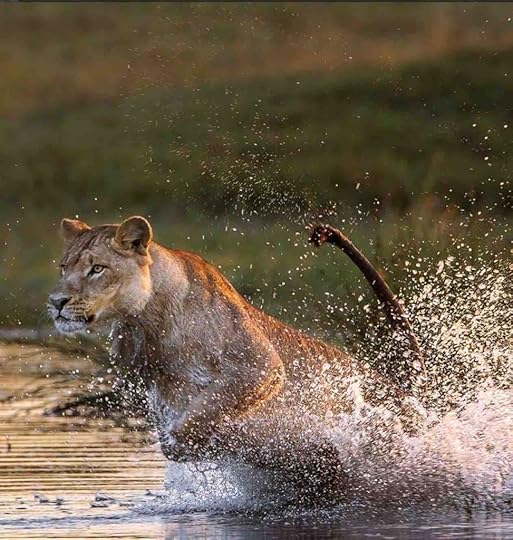 Seeing lions swim across water is a highlight on a Botswana African safari.
Seeing lions swim across water is a highlight on a Botswana African safari.I’m Lori Robinson, a safari specialist who has been traveling to Africa for 34 years and designing safaris for families, couples, and celebrities including Jane Goodall, and non-profit organizations since 2004.
Here are my top tips for planning an African Safari.
Planning an African safari is very different than planning a trip to Europe, or Australia for instance. Unless you’re doing a self-drive, ground-camping excursion (definitely not recommended for foreigners or people who are not experienced Africa travelers) you will need a ‘safari operator’ to put your trip together for you. You can’t get around this. The whole safari industry is based on using safari operators as the go-between the tourist and the lodges and guides. I have used all of the top operators and can recommend which one is right for you.
Choose an operator who specializes in Africa. Travel agencies who offer trips all over the world are not specialists, and rarely do their agents ever visit Africa. These agencies offer cookie-cutter safari itineraries with little ability to personally design your trip. Skip those in favor of an operator that is intimately familiar with Africa and able to help you sort through all the options to custom design an itinerary that fits your specific needs. There are hundreds of operators to choose from and I have worked with many of them. I’m happy to guide you to the right one for your specific needs.
Get clear on your dream. Do you want to see as many different animals as possible, or do you want to focus on one species like elephants? Do you want a cultural element like visiting indigenous tribes, or to add an activity or famous landmark into your itinerary – like taking a helicopter ride over Victoria Falls, hiking to see gorillas, going down into the Ngorongoro Crater, or trekking with an organization working to save rhinos? Do you want to include a charitable component? What is it that you picture yourself doing? This is your dream and you need to make sure you fulfill it.
Accept the fact that this will be an expensive trip. The best places to stay on safari are located in the areas with the most wildlife. These places are exclusive and expensive. The lodgings I recommend are called Tented Camps. These camps host smaller groups and provide first-class amenities, guides, service, and food. These smaller camps are always my client’s favorite. You can hear the lions roaring at night, and have to be escorted back to your tent after dinner because of animals wandering around. It’s definitely an experience that adds to the allure and adventure of your safari.
 Typical style small tented camps in my itineraries.
Typical style small tented camps in my itineraries.The most popular countries for safaris are Kenya and Tanzania in East Africa, and Botswana, South Africa, and Zimbabwe in Southern Africa. My first choice for first-time safari travelers is East Africa for the sheer numbers of animals (the wildebeest migration happens there) as well as cultural options such as visiting a traditional Maasai village and being guided by Maasai warriors. Set up a phone call with me to talk you through the differences of going on safari in each country.
Choosing the right time of year for the country you will visit maximizes your wildlife experiences. If you have to travel within a range of set dates, make sure you choose the Parks that offer the best experience for those dates. If you are flexible with your dates of travel then choose the country and time of year that offers you what you dream of doing.
Don’t let the excuse that you have always wanted to go to Africa but can’t find anyone to travel with, stop you. If you want to go on safari but don’t want to travel on your own, ask me about the safari’s I personally lead each year for small groups of like-minded travelers.
If you want more tips, email me, lorisavingwild@gmail.com, to set up a time to talk directly to get all your questions answered. I look forward to hearing from you and helping you create a life-changing African safari.
The post Lori Robinson’s Ultimate Guide to Planning an African Safari appeared first on .
Beginners Guide to Planning an African Safari
If you’ve begun researching and planning an African Safari you know it’s a daunting task. The internet offers hundreds, if not thousands, of different answers for each of your safari queries.
But in the case of traveling to Africa, the best safari experiences absolutely do depend on when, where and how you go. Time your trip correctly, chose the top country, and the best parks and camps within that country, and use an operator who is well versed in Africa and you will have the trip of a lifetime.

I’m a safari consultant who has been traveling to Africa for 34 years and designing safaris for families, couples, and celebrities including Jane Goodall, and non-profit organizations for the past 15 years.
Here are my top tips for planning an African Safari.
Planning an African safari is very different than planning a trip to Europe, or Australia for instance. Unless you’re doing a self-drive, ground-camping excursion (definitely not recommended for foreigners or people who are not experienced Africa travelers) you will need a ‘safari operator’ to put your trip together for you. You can’t get around this. The whole safari industry is based on using safari operators as the go between the tourist and the lodges and guides.
Choose an operator who specializes in Africa. Travel agencies who offer trips all over the world are not specialists and rarely do their agents ever visit Africa. These agencies offer cookie-cutter safari itineraries with little ability to personally design your trip. Skip those in favor of an operator that is intimately familiar with Africa and able to help you sort through all the options to custom design an itinerary that fits your specific needs. There are hundreds of operators to choose from and I have worked with many of them. I’m happy to guide you to the right one for your specific needs.
Get clear on your dream. Do you want to see as many different animals as possible, or do you want to focus on one species like elephants? Do you want a cultural element like visiting indigenous tribes, or to add an activity or famous landmark into your itinerary – like taking a helicopter ride over Victoria Falls, hiking to see gorillas, going down into the Ngorongoro Crater, or trekking with an organization working to save rhinos? What is it that you picture yourself doing? This is your dream and you need to make sure you fulfill it.
Accept the fact that this will be an expensive trip. The best places to stay on safari are located in the areas with the most wildlife. These places are exclusive and expensive. The lodgings I recommend are called Tented Camps. These camps host smaller groups and provide first-class amenities, guides, service, and food. These smaller camps are always my client’s favorite. You can hear the lions roaring at night, and have to be escorted back to your tent after dinner because of animals wandering around. It’s definitely an experience that adds to the allure and adventure of your safari.
 Typical style small tented camps in my itineraries.
Typical style small tented camps in my itineraries.The most popular countries for safari goers are Kenya and Tanzania in East Africa, and Botswana, South Africa, and Zimbabwe in Southern Africa. My first choice for first-time safari travelers is East Africa for the sheer numbers of animals (the wildebeest migration happens there) as well as cultural options such as visiting a traditional Maasai village and being guided by Maasai warriors. Set up a phone call with me to talk you through the differences of going on safari in each country.
Choosing the right time of year for the country you will visit maximizes your wildlife experiences. If you have to travel within a range of set dates, make sure you choose the Parks that offer the best experience for those dates. If you are flexible with your dates of travel then choose the country and time of year that offers you what you dream of doing.
Don’t let the excuse that you have always wanted to go to Africa but can’t find anyone to travel with, stop you. If you want to go on safari but don’t want to travel on your own, ask me about the safari’s I personally lead each year for small groups of like-minded travelers.
Email me, lorisavingwild@gmail.com, to set up a time to talk directly to get all your questions answered. I look forward to hearing from you and helping you create a life-changing African safari.
The post Beginners Guide to Planning an African Safari appeared first on .
March 25, 2019
Jane Goodall’s Birthday Inspiration
Jane Goodall’s birthday is April 3rd. She will be 85. By that time in life, most people have chosen to retire, slow down and live a more quiet life. But Jane Goodall has done the opposite.
She has turned up the volume on her work to save the world’s wild ones and wild places. She travels over 300 days per year giving lectures, attending meetings like CITIES, accepting honors, and visiting and inspiring hoards of school children who are members of her worldwide Roots & Shoots program.
If there is news about wildlife, Jane is usually the first to give a comment or make a widely quoted statement.
In every way, she is a model for a life well lived. And there are many things we can learn from Jane.
To celebrate Jane Goodall’s birthday I am highlighting 14 characteristics of Dr. Jane that have made her into the amazing role model she is. I believe any of us can use some of these attributes to help us live our uniquely best life.
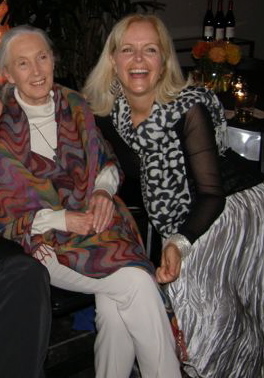 Dr. Jane has been my role model since I was about six years old.
Dr. Jane has been my role model since I was about six years old.First, Find your passion and do not waiver from it. Practically since she was born Jane Goodall knew she wanted to help animals. Imagine if you’ve spent 20, 40, 80 years focused on one thing. You would be an expert at it. And you would achieve a lot. Most of us get taken off our path because of impatience or because of family or cultural pressure. Find your passion and stick with it.
Be Yourself. There is no doubt in anyone’s mind what Jane Goodall stands for. She follows her own calling and passion. That makes her both unique and highly effective. So be yourself. Everyone else is taken.
Be disciplined. Jane has a mission-like attitude. Indeed she is on a mission, and you feel it from all of her actions. She gets the job done no matter how tired, or overworked she is. And she doesn’t complain.
Surround yourself with influential friends. And do things for them. Jane sometimes lends her name for events her friends are doing. She did a foreword for one of my books. She is generous with her time and heart. And people want to be around her and give back to her as well. Dave Matthews auctioned off one of his guitars for the Jane Goodall Institute. The motivational speakers all tell us, “you are only as successful as the people you surround yourself with.” So surround yourself with people you want to emulate.
Be determined. Did you know that Jane had to overcome her shyness in order to be a speaker? She had to overcome many obstacles to be able to do field work in Gombe Stream, and late in life she changed her career focus from a scientist to a conservationist to better help animals. Determination will get you far along your path in life.
Adopt a minimalist mindset. Although I doubt Jane cares about the label of minimalist, she has always lived simply, even before this lifestyle was popular. Her staff told me she lives out of one small piece of luggage.
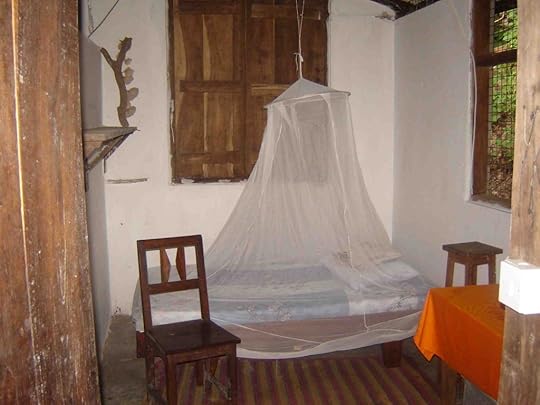 Dr. Jane’s bed at her house in Tanzania.
Dr. Jane’s bed at her house in Tanzania.Walk your talk. Knowing who you are, and what you are most passionate about, makes you believable to others. Because meat consumption is a huge contributor to climate change, and because of the abuse and suffering animals endure as livestock, Jane is a vegan except when her grueling travel schedule only has vegetarian options. Take a stand for what you believe in and make sure you make all your lifestyle choices reflect your values and beliefs.
Don’t give up. In the preface of my book, Saving Wild, Inspiration From Fifty Leading Conservationists , I tell a story. It’s about the time I asked Jane how she keeps going despite all the overwhelming bad news in the world. She fixed her green gold-specked eyes on mine and said, “I don’t give up.” At 85 Jane is probably doing more than ever to share her cause. The words, don’t give up, are simple. But they can be very difficult to put into action.
Keep a sense of humor. Even though Dr. Jane works in a field that is challenging, and at times overwhelming and depressing, she seems to remain in good spirits.
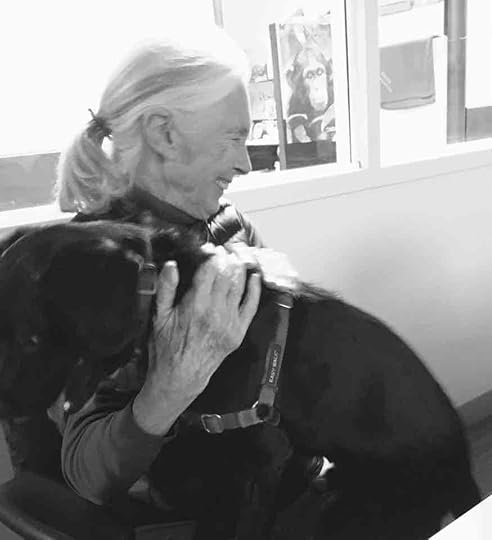
Remain Hopeful. Despite the fact that conservation is one of the most difficult fields to work in, she does not seem to give up hope. In fact, she is famous for her lectures and many books full of reasons for hope.
Give people your full attention. If you have ever met and had a conversation with Jane you know she looks you straight in the eyes making you feel there is no one else in the room.
Say Yes. Jane graciously gives her name to causes that are in line with the mission of her Jane Goodall Institute. That selflessness has only served to expand her name and message across the world.
Learn to speak well. Jane is one of the best public speakers I have ever heard. Every one of her lectures has a signature beginning that initially grabs the audience’s attention. Watch her signature opening on my YouTube channel here. She then touches people by telling stories and evoking emotion. At a recent talk she gave in Santa Fe, New Mexico I noticed people crying and laughing.
Be humble. Dr. Jane Goodall is perhaps the best-known name in the world related to conservation and animals, yet she remains unpretentious, simple and gracious.
We need inspiration now more than ever. And Dr. Jane continues to provide it through her work, and who she is in the world.
Send your wishes for Jane Goodall’s birthday in the comment section below.
For more on Jane Goodall check out my post, What you don’t know about Dr. Jane.
The post Jane Goodall’s Birthday Inspiration appeared first on .
January 31, 2019
How Touching Whales Helped Me Get A Divorce
When one of the largest animals in the world surfaces within two feet of my kyak, while people scream from the upper deck of a nearby whale- watching boat, “Watch out, you’re going to be capsized,” a normal reaction would be to paddle away from there as fast as humanly possible.
Instead, I rest my oar on my lap and smile widely to the well-meaning crowd. I don’t want to miss this close encounter with a whale.
If this were a month earlier I wouldn’t have been this relaxed. But I’ve just returned from three days of intimate moments with gray whales in Mexico, and I’m now confident the 40-ton animal swimming next to me has no interest in capsizing my tiny kyak.
“Other animals sometimes seem to recognize in us a kind of kindred consciousness that we often fail to recognize in them.” From the book Beyond Words by Carl Safina.
~~~~~~~~~~~~~~~~~
I want to touch a whale. It’s a bucket list thing.
But I’m also feeling stuck and unhappy in a marriage that is not working for either of us. Being in Nature is always my antidote for big life issues. And my marital situation qualifies.
So I take a trip to meet whales in Mexico. On my first night, tucked in a canvas tent, on the sandy edge of San Ignacio lagoon, I lay awake for hours excitedly listening to hundreds of whales breaching and slapping the water with their flukes. What are they saying to each other? What are they saying to me?
In the morning our panga driver motors 5 tourists, me, and Chris, our naturalist, around the lagoon hoping for an ‘encounter.’
Every year gray whales migrate south from their feeding areas in the frigid waters of the Bering and Chukchi Seas, to mate and give birth in the relatively calm warm water ‘nursery’ of Magdalena Bay in Baja California and this place, San Ignacio lagoon in Mexico. Their 10,000-mile round-trip journey is the longest migration of any mammal.
Salty spray sprinkles our faces as we bounce over the waves. “There,” Chris said, pointing to a ‘footprint’, a smooth oval shape created when the whales propel themselves deeper underwater. Our driver idles the engine, an invitation that we are available for a visit if and when the whales are ready.
We lean over the side of the boat to slap the surface of the water. “It calls the whales in,” Chris tells us. “They are very curious beings.” As I slap, I’m silently begging the whales: Pick our boat. We’re friendly. We love you.
Within minutes an animal the length of our skiff appears just below the surface a few feet away.
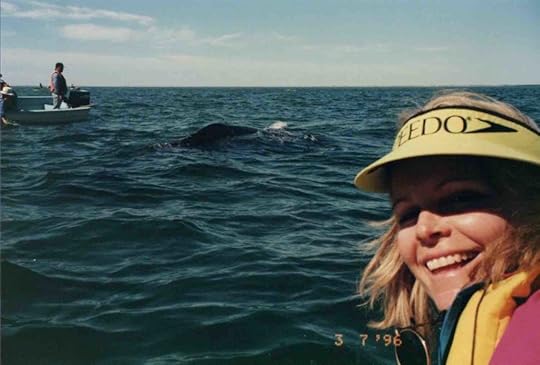 Our first close encounter is about to happen.
Our first close encounter is about to happen.It’s a baby.
I stretch out over the side of the boat, reaching, reaching, reaching. Then mom swims under and lifts her baby so the top curve of its spine is out of the water and I make skin to skin contact. Slowly running my hand across the rubbery soft dark gray skin, I avoid the mottled white patches of sharply edged barnacles that have taken up permanent residence.
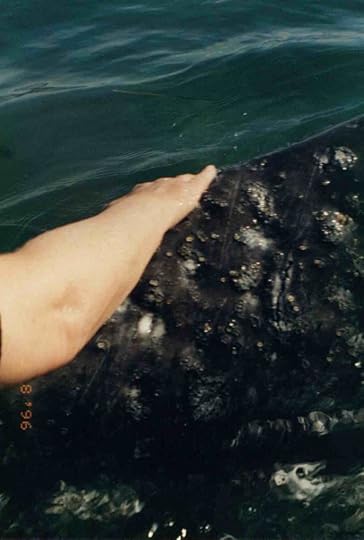 Contact.
Contact.Time stands still. Then the baby swims out of the way as the 40-foot long mother maneuvers sideways until I am looking straight into her left eye. As I write this I can feel the tears wanting to flow again. I remember ‘knowing’ something I did not then ‘understand.’ This female whale is initiating contact with us humans. Every cell in my body can feel her connecting to me.
In her presence, I sense a vast pool of peacefulness, understanding and wisdom. She knows things I can never know – about the planet – about the earth, about her water world, and about me.
I feel completely present and ‘in the moment’ and as if I am enveloped by the purest love I have ever known.
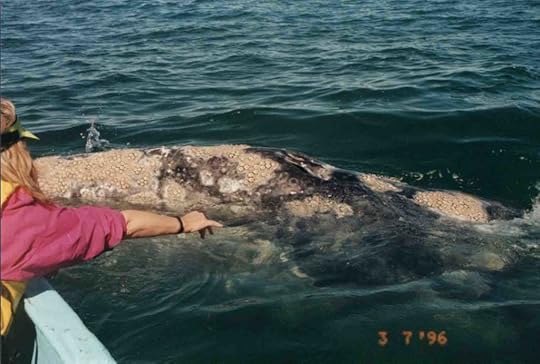 I wanted to touch every whale we saw, and there were hundreds.
I wanted to touch every whale we saw, and there were hundreds.For the next three days, each time I ‘meet’ a whale I feel as if I’m being blessed by an ancient soul. As if I am in a loving mothers womb, protected and supported. Each encounter leaves me clearer and stronger.
When I return home to Santa Barbara it is those whales that continue, during the following year, to give me the courage and fortitude needed to finalize my divorce.
~~~~~~~~~~~~~~~~~~~~~~~~~~~~~
If touching whales is on your bucket list, January through April are the best months to go. There are many tour operators you can use, or you can plan it on your own. San Ignacio Lagoon and Magdalena Bay are the top two spots for touching whales. But be warned, touching whales may drastically change your life.
LvL
*Photos by Chris Peterson
The post How Touching Whales Helped Me Get A Divorce appeared first on .
January 6, 2019
Solutions for the Planet from Key Biscayne, FL
If you’ve followed me here on my SavingWild.com blog, or on social media, for a while you know I love highlighting solutions for the planet and things that inspire us all to live more connected to Nature.
Recently I blogged about selling my house in order to try a vagabond lifestyle for a year.
My first stop on this journey is Key Biscayne, Florida.
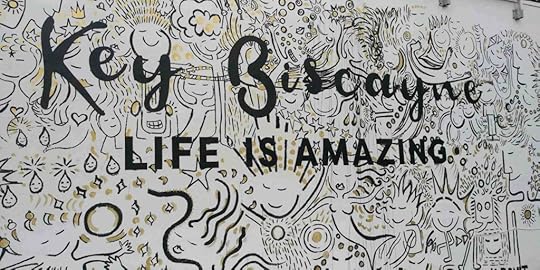
It’s where I was born, and the place where the famous dolphin, Flipper, died in Ric O’Barry’s arms turning him into an activist to free dolphins from marine parks. You can read his story in my book, Wild Lives. This is also the home office of The Key Biscayne Foundation, the fiscal umbrella for donations made to SavingWild.
But today I want to tell you about a couple of initiatives the Key Biscayne Foundation has put into place since I was last here two years ago.
Two Solutions for the Planet
Friendly enclosed electric golf carts traverse the five-mile long, two-mile wide, palm-lined island, picking up and delivering passengers for free. It’s so efficient my resident father no longer owns a car. For local transport, he walks or uses the Freebe (that’s what it’s called). And to get off the island he uses Lyft.
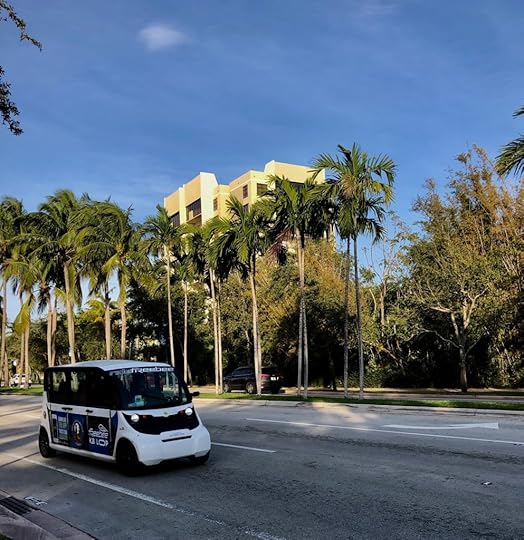
I’ve used the Freebe a few times but prefer the bright green colored bikes randomly parked all over the island. With the Lime Bike App, I unlock any of their bikes for $1 and ride as long as I want for five cents per minute. It never takes more than a few minutes to walk to find a bike. And when I’m done riding I simply lock and leave the bicycle in wait for the next person. I’ve been in Key Biscayne for almost a month and have yet to rent a car.
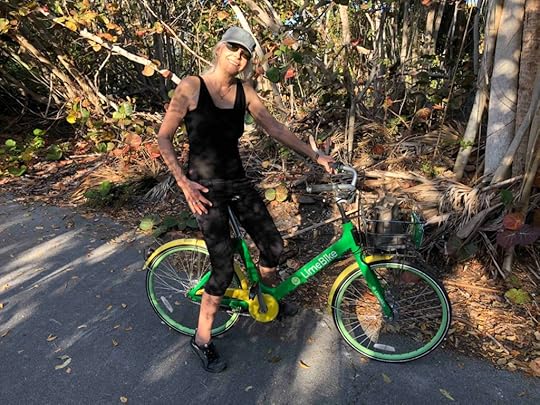 I am in love with these Lime Bikes. Those are NOT tattoos on my arm – they are shade patterns from the leaves.
I am in love with these Lime Bikes. Those are NOT tattoos on my arm – they are shade patterns from the leaves.Can you imagine if all small communities across the globe offered these options? And people used them. We would cut down on traffic, and pollution and encourage more exercise. They are both great examples of solutions for the planet.
If you know of any small towns and cities offering similar services I would love to hear about them in the comment section below. I am seriously considering focusing my Vagabond journey on places where I can avoid using cars as much as possible.
The post Solutions for the Planet from Key Biscayne, FL appeared first on .
January 1, 2019
My Inconvenient Journey for More
This year is all about me embracing inconvenience. And fear.
Challenging myself.
I have moved out of my comfort zone into completely unknown, inconvenient territory. And I ’m anxious. If the well-known family therapist Virgina Satir were still alive she would ask me, “Are you anxious or are you excited?”
I’m both.
Last month I sold my small adobe mud house in Santa Fe.
 My sweet mud home in Santa Fe surrounded by woods
My sweet mud home in Santa Fe surrounded by woodsI had never planned for New Mexico to be my forever home. The altitude and desert dryness did not suit me.
I could no longer postpone the inevitable overwhelm of selling most of my things (again), saying teary goodbyes to my half-sisters and nieces, new friends, and the coyote, deer, and birds that were my daily visitors for the past three and a half years.
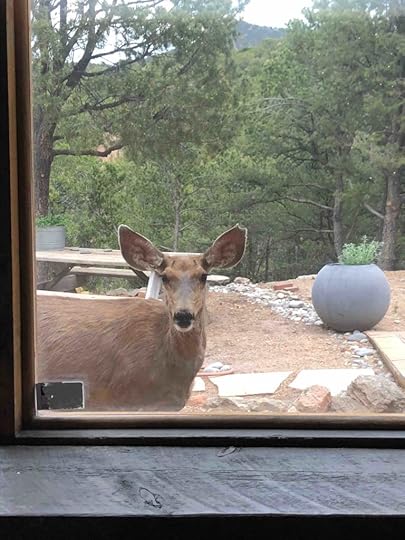 Saying goodbye to my wild friends was one of the hardest things I have ever done.
Saying goodbye to my wild friends was one of the hardest things I have ever done.But difficulty is an important factor for human experience. Convenience is all destination and no journey. And it can enslave us, dull us, and close off options for growth. I’m choosing the journey.
What am I going to do?
That’s the question everyone asks me. My answer goes something like this: I have a vague vision of traveling for a year, mostly in Africa. It’s a dream I’ve carried for a while but could not manifest for various reasons. Now, I have nothing standing in my way. Except the inconvenient fear and struggle of being a single woman in her sixties setting up a vagabond life with no home base. Just writing that brings on the anxious feelings.
As my year unfolds I will try to remain on the excited side of my anxiety (thank you Virgina Satir) and continually remind myself that struggle is not always the problem. It’s also the solution.
Let me know in the comments below if you would like me to post about my inconvenient journey resisting the stupefying power of safe and convenient and seeing what happens. Let me know if you would like to follow along through blog posts like this one.
LvL
The post My Inconvenient Journey for More appeared first on .
November 13, 2018
Five NGO’s Helping Animals that deserve your 2019 donation
You have enough to do during this holiday/giving season then spend your time researching which organizations deserve your donations. So let me help you.
Here are my favorite five non-governmental organizations helping animals.
I have personally vetted each of these, giving them a ‘thumbs up’ for their effectiveness, ethics, and ability to use your money wisely. They are all unique and probably ones you have not heard of.
If you want to help animals, you can’t go wrong donating to any, or all, of these wonderful organizations.
On the other hand, maybe you want to avoid sending out five separate donations, and being solicited from them in the future?
Then simply donate to SavingWild here:
 [Note: Donations are processed through our non-profit umbrella, The Key Biscayne Foundation, and are fully tax-deductible.]
[Note: Donations are processed through our non-profit umbrella, The Key Biscayne Foundation, and are fully tax-deductible.] Your money will be bundled with other donors and distributed among these five organizations helping animals. And we never send out solicitations!
Here are my Favorite five NGO’s Helping Animals
I recently had the privilege of visiting this new sanctuary in Northern Kenya’s Samburu region. So many of the orphaned elephants in Kenya come from this area so it makes my heart sing to know that these traumatized babies can now be taken care of on the land they are familiar with, near elephant families they recognize, rather than flown or trucked hours away to be cared for in Nairobi.
Created by the Wildlife Conservation Network in partnership with the Leonardo DiCaprio Foundation, the Lion Recovery Fund invests in projects in both Africa and in western donor countries committed to recovering lions and restoring their wild landscapes. The Fund’s goal is to operate until lions are on a clear path toward doubling their numbers across Africa.
Animal Defenders International
It seems like I receive news from ADI on a weekly basis about their efforts to rescue lions and tigers from life as a circus act. This organization is busy all over the world identifying abuse and providing rescue. I admire their work, but beware that once you are on their list, you will receive an overwhelming number of solicitations.
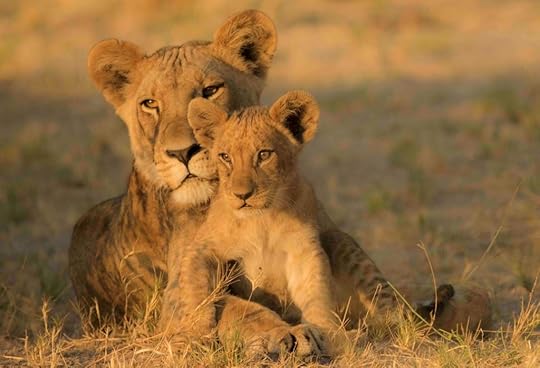 Photos by safari client Henry Holdsworth @Wild by Nature Gallery
Photos by safari client Henry Holdsworth @Wild by Nature Gallery
Great Plains Foundation supports the work of Great Plains Conservation which acquires and then converts hunting concessions into conservation areas in Africa. The Foundation arm creates and funds projects that will rehabilitate, enhance and save the wildlife in these protected areas. I support anything Dereck and Beverly Joubert are connected to, including using some of their wonderful Tented Camps in my safari itineraries. Visit my YouTube channel to get a feel for some of the camps I like.
A model for the future of conservation around the globe, NRT empowers local people to build sustainable economies linked to conservation and the protection of wild spaces, and mend years of tribal conflict. NRT was founded by Ian Craig, one of the conservationist heroes in my book, Wild Lives. I often include this area of in Northern Kenya on my safari itineraries. It is full of the Big Five and my clients can learn about the amazing work they are doing.
Make it Simple. Donate to SavingWild and we will bundle your donation with others and distribute it for you.
DONATE DIRECTLY TO SAVINGWILD USING THIS LINK:

[Donations are processed through our non-profit umbrella, The Key Biscayne Foundation, and are fully tax-deductible.]
The post Five NGO’s Helping Animals that deserve your 2019 donation appeared first on .
Five NGO’s Helping Animals that deserve your 2018 donation
You have enough to do during this Holiday/Giving season then spend your time researching which organizations deserve your donations. So I’ve decided to help you.
Here are my favorite five non-governmental organizations helping animals. I have personally vetted each of these, giving them a ‘thumbs up’ for their effectiveness, ethics, and ability to use your money wisely. You can’t go wrong donating to any, or all, of these wonderful organizations.
Want to avoid sending five separate donations, and being solicited in the future? Then simply donate to SavingWild here:

[Note: Donations are processed through our non-profit umbrella, The Key Biscayne Foundation, and are fully tax-deductible.]
Your money will be bundled with other donors and distributed among these five organizations helping animals. And we never send out solicitations!
Here are my Favorite five NGO’s Helping Animals
I recently had the privilege of visiting this new sanctuary in Northern Kenya’s Samburu region. So many of the orphaned elephants in Kenya come from this area so it makes my heart sing to know that these traumatized babies can now be taken care of on the land they are familiar with, near elephant families they recognize, rather than flown or trucked for care hours away in Nairobi.
Created by the Wildlife Conservation Network in partnership with the Leonardo DiCaprio Foundation, the Lion Recovery Fund invests in projects in both Africa and in western donor countries committed to recovering lions and restoring their wild landscapes. The Fund’s goal is to operate until lions are on a clear path toward doubling their numbers across Africa.
Animal Defenders International
It seems like I receive news from ADI on a weekly basis about their efforts to rescue lions and tigers from life as a circus act. This organization is busy all over the world identifying abuse and providing rescue. I admire their work, but beware that once you are on their list, you will receive an overwhelming number of solicitations.
 Photos by safari client Henry Holdsworth @Wild by Nature Gallery
Photos by safari client Henry Holdsworth @Wild by Nature Gallery
Great Plains Foundation supports the work of Great Plains Conservation which acquires and then converts hunting concessions into conservation areas in Africa. The Foundation arm creates and funds projects that will rehabilitate, enhance and save the wildlife in these protected areas. I support anything Dereck and Beverly Joubert are connected to.
A model for the future of conservation around the globe, NRT empowers local people to build sustainable economies linked to conservation and the protection of wild spaces, and mend years of tribal conflict. Founded by Ian Craig, one of the conservationist heroes in my book, Wild Lives. The safaris I lead in Kenya always visit the NRT area to learn about their amazing work.
Make it Simple. Donate to SavingWild and we will bundle your donation with others and distribute it for you.
DONATE DIRECTLY TO SAVINGWILD USING THIS LINK:

[Donations are processed through our non-profit umbrella, The Key Biscayne Foundation, and are fully tax-deductible.]
The post Five NGO’s Helping Animals that deserve your 2018 donation appeared first on .



